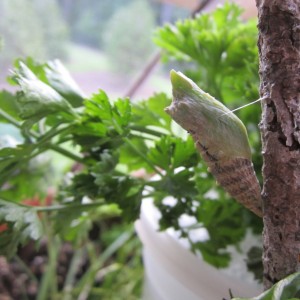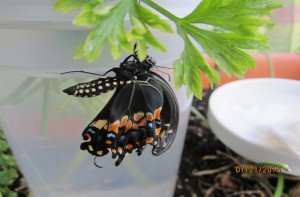Why not kick off spring by raising Eastern Black Swallowtail butterflies and watching their beauty unfold? Butterfly “farming” is easy, fun, and rewarding for kids of all ages.
 Start with a container that can be covered with removable screen for ventilation and easy access. A 10-gallon aquarium from a thrift shop works well. I cover mine with fiberglass netting and secure the netting with a bungee cord. Line the aquarium floor with six to eight layers of newspaper for easy clean up. Add several food holders. I make these from small plastic deli containers as follows: cut small slits in the lids, fill the deli containers with water, replace the lids and stuff stems of parsley through the slits—tightly bunching the stems so the caterpillars cannot get into the water and drown. Put the aquarium in a sheltered area (deck, porch) out of direct sunlight.
Start with a container that can be covered with removable screen for ventilation and easy access. A 10-gallon aquarium from a thrift shop works well. I cover mine with fiberglass netting and secure the netting with a bungee cord. Line the aquarium floor with six to eight layers of newspaper for easy clean up. Add several food holders. I make these from small plastic deli containers as follows: cut small slits in the lids, fill the deli containers with water, replace the lids and stuff stems of parsley through the slits—tightly bunching the stems so the caterpillars cannot get into the water and drown. Put the aquarium in a sheltered area (deck, porch) out of direct sunlight.
Now the fun begins. Find a host plant–parsley is a good candidate—and look for eggs. Carefully check any host plant for predators (ants, spiders, small wasps) before putting it into the container. In the butterfly life cycle, eggs hatch and caterpillar larvae (instars) appear within 4-13 days (longer in cooler temperatures). Instars go through five stages, taking anywhere from several weeks to many months. Early instars are camouflaged to look like bird droppings. Gradually a white or orange band appears mid-body. The second through fifth stages last approximately 10 days. Caterpillars become voracious eaters during this time, growing quickly and changing appearance. It is an intensive period of feeding and cleaning.
 Caterpillars continue eating as they morph until the fifth (last) instar stage. Instars get noticeably fatter (about size of the little finger) as they prepare to pupate or form the chrysalis. “Chrysalis” is the correct term for butterflies, whereas “cocoon” refers to moths. At this point, instars stop eating, purge most system fluids to reduce their size, “bow” their head in a candy cane or upside down “J” shape, and look for a place to attach.
Caterpillars continue eating as they morph until the fifth (last) instar stage. Instars get noticeably fatter (about size of the little finger) as they prepare to pupate or form the chrysalis. “Chrysalis” is the correct term for butterflies, whereas “cocoon” refers to moths. At this point, instars stop eating, purge most system fluids to reduce their size, “bow” their head in a candy cane or upside down “J” shape, and look for a place to attach.
 I add clean twigs to the container at this time, although instars will attach to anything in the container (tank rim, underside of the screen, or food containers). Position twigs so that chrysalises can hang with enough space for emerging butterflies to spread and dry their wings. Chrysalises are brown or green and usually last 18-20 days. If they form after September, they overwinter and adults emerge the following spring. Feeding is not required during this time. The screen-covered container may be stored in a protected area outside—out of direct sun.
I add clean twigs to the container at this time, although instars will attach to anything in the container (tank rim, underside of the screen, or food containers). Position twigs so that chrysalises can hang with enough space for emerging butterflies to spread and dry their wings. Chrysalises are brown or green and usually last 18-20 days. If they form after September, they overwinter and adults emerge the following spring. Feeding is not required during this time. The screen-covered container may be stored in a protected area outside—out of direct sun.
 Butterflies take from several days to many months to emerge. Their wings are very soft at hatching and must not be touched for several hours, so they can dry before flight. Release butterflies within 1-2 days but not on a rainy day. Expect two to three broods each summer, one in mid-June and the second in August—September. Over-wintered adults emerge in early spring. Males and females are easy to distinguish. Check the colored spots on their open wings. Males have more yellow spots, whereas females have more blue.
Butterflies take from several days to many months to emerge. Their wings are very soft at hatching and must not be touched for several hours, so they can dry before flight. Release butterflies within 1-2 days but not on a rainy day. Expect two to three broods each summer, one in mid-June and the second in August—September. Over-wintered adults emerge in early spring. Males and females are easy to distinguish. Check the colored spots on their open wings. Males have more yellow spots, whereas females have more blue.
Eastern Black Swallowtails are short-lived, surviving only two to four weeks after hatching. They do not migrate. This spring, have fun adding these pollinators to the ecosystem but be advised: Raising butterflies is addictive!

